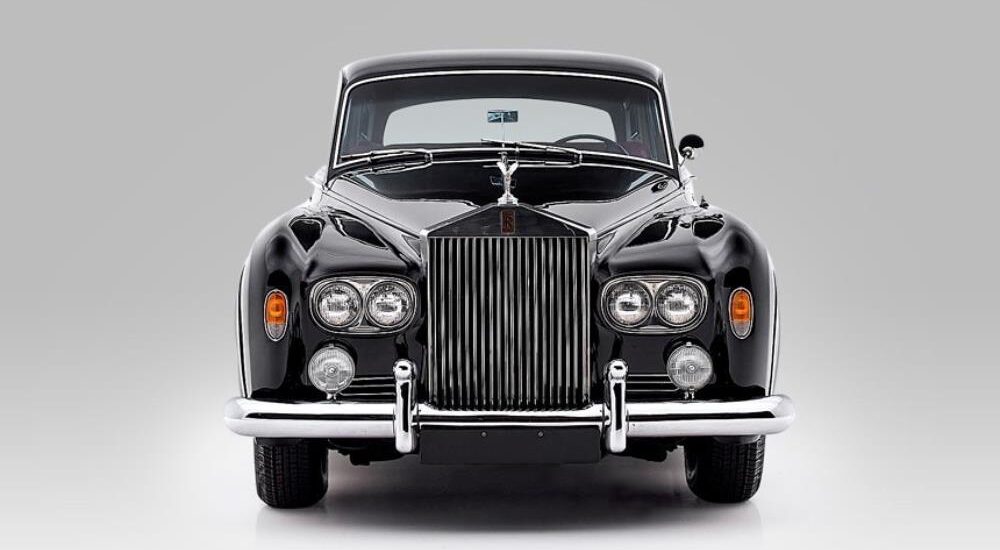Rolls-Royce, la quintessenza della casa automobilistica britannica di lusso, non ha mai gestito una propria divisione di produzione di carrozzerie. Fin dall’inizio, l’azienda si è concentrata sul raggiungimento della massima qualità possibile nella produzione di telai per l’epoca, lasciando il compito estetico di “vestire” il telaio ai maestri carrozzieri, molto numerosi nell’Inghilterra dei primi del Novecento. Tuttavia, i tempi si sono evoluti e così Rolls-Royce.
Per decenni, la Rolls-Royce si è attenuta alla sua strategia commerciale, rimanendo ferma anche durante la Grande Depressione, che mise a dura prova la domanda del mercato per le sue offerte di lusso. Fu solo durante la Seconda Guerra Mondiale che lo schema di produzione tradizionale cominciò a mostrare segni di tensione.

Nell’Inghilterra del dopoguerra, il numero di carrozzerie indipendenti si ridusse notevolmente rispetto al periodo interbellico. Alcune furono decimate dalla Grande Depressione, altre, dopo essere passate alla produzione bellica, non riuscirono a tornare al lavoro civile; poche fortunate si fusero con le principali case automobilistiche. Ad esempio, Park Ward, che prima della guerra era caduta sotto l’influenza di Rolls-Royce, svolse un ruolo cruciale nel passaggio alle carrozzerie interamente in metallo. Pur mantenendo formalmente il proprio marchio indipendente, la stretta associazione con Rolls-Royce non fu pubblicizzata direttamente.

Il passaggio all’utilizzo di carrozzerie standard “di fabbrica” iniziò cautamente nel 1946 con la Bentley Mark VI. Queste carrozzerie, pur essendo nominalmente prodotte in fabbrica, venivano fornite per contratto, non da un prestigioso carrozziere, ma dalla Pressed Steel Company, un impianto di lavorazione dei metalli fondato nel 1926. Questo stabilimento, inizialmente una joint venture tra la Morris Motors e il gigante americano Budd Corporation, era ormai diventato un produttore indipendente specializzato nello stampaggio a freddo, in grado di fornire scocche complete a varie case automobilistiche: un contratto prestigioso per qualsiasi azienda, soprattutto per una come la Rolls-Royce.

A giudicare dai minuscoli monogrammi RR tra i fari, questo esemplare è stato prodotto nella seconda metà del 1964 – e quindi appartiene all’ultimo periodo: già nel 1965 questo modello lasciò il posto in produzione alla più moderna Silver Shadow.
La “carrozzeria in bianco” arrivava allo stabilimento Rolls-Royce di Crewe completamente assemblata, con la finitura finale e la verniciatura eseguite su una linea di produzione dedicata, allestita appositamente per questo scopo. Dopo aver perfezionato questo metodo di produzione con la Bentley Mark VI, alla fine degli anni Quaranta Rolls-Royce iniziò a commercializzare alcuni di questi veicoli con il proprio marchio, principalmente per l’esportazione, adattandone di conseguenza gli esterni. Questa iniziativa portò alla nascita della Rolls-Royce Silver Dawn, prodotta dal 1949 al 1955, che ebbe successo sia all’estero che nel Regno Unito (dall’ottobre 1953 con il volante correttamente posizionato per il mercato britannico). Questo modello vendette 760 unità prima di essere sostituito nella gamma dalla più moderna Silver Cloud, oggetto del nostro articolo.


Gli interni dell’auto sono all’insegna del lusso discreto. Se è in pelle, allora è della migliore qualità, se è in legno, allora è necessariamente di specie pregiate. Un’altra caratteristica dell’ultimo modello è rappresentata dai sedili anteriori, realizzati in materiale separato.
La carrozzeria della Silver Cloud fu progettata dal talentuoso John Blatchley, un genio autodidatta che passò alla Rolls-Royce dal rinomato carrozziere J. Gurney Nutting. Nonostante fosse stato privato dell’istruzione formale a causa di una grave malattia in gioventù, il talento naturale di Blatchley compensava la sua mancanza di formazione professionale. Tra i suoi risultati degni di nota ci sono lo sviluppo della Bentley Mark VI e la sua trasformazione nella Rolls-Royce Silver Dawn. Fondò inoltre la divisione di design automobilistico della Rolls-Royce Ltd.. Incaricato di progettare la Silver Cloud da zero a metà degli anni Cinquanta, il progetto iniziale di Blatchley fu respinto dalla leadership conservatrice dell’azienda perché troppo moderno. In un’intervista rilasciata nel 1996 a Giles Chapman di Classic & Sports Car, Blatchley ha ricordato: “All’epoca ero profondamente influenzato dall’approccio americano allo stile della carrozzeria, che si rifletteva nel mio progetto. Fu sviluppato in un modello di presentazione di grandi dimensioni… Durante la presentazione, la direzione mi ordinò di creare qualcosa di più tradizionale. Sul momento, schizzai su un foglio di carta grigia e con una matita bianca l’aspetto di questo “più tradizionale”, un’idea approssimativa con la forma del radiatore e lo stemma distintivi della Bentley. L’hanno accettata immediatamente, non solo come base, ma come era…”.

Il quadro strumenti è disposto in modo simmetrico: il quadrante di sinistra è il tachimetro, quello di destra contiene tutte le altre scale, mentre l’interruttore di accensione e alcuni comandi elettrici si trovano sul pannello rotondo al centro. Il ricevitore radio di questo esemplare è tedesco, della Blaupunkt.
Il nuovo modello debuttò nel 1955 sia come Rolls-Royce Silver Cloud che come Bentley Type S, continuando l’evoluzione del design stabilita dai suoi predecessori. Il motore era un sei cilindri in linea a valvole in testa, il cambio automatico (di serie dal 1953), le sospensioni anteriori indipendenti, l’asse posteriore in tensione e i freni a tamburo servoassistiti su tutte le ruote. Con l’avanzare dei progressi, fu aggiunto il servosterzo, inizialmente come optional e successivamente come dotazione di serie. Le sospensioni anteriori e la trasmissione erano basate su progetti americani, con brevetti acquisiti dalla General Motors. Nel 1957 fu introdotta una variante a passo allungato, che migliorava lo spazio dell’abitacolo posteriore. La struttura del telaio consentiva comunque di realizzare versioni personalizzate se i clienti desideravano un design su misura da parte dei pochi carrozzieri indipendenti rimasti.


I passeggeri dei sedili posteriori sono dotati non solo di cinture di sicurezza, ma anche di un comodo bracciolo centrale, che può essere rimosso quando non serve, e di tavolini pieghevoli montati sugli schienali dei sedili anteriori.
Alla fine degli anni Cinquanta, Rolls-Royce decise di passare a un motore a otto cilindri a V, ritenendo che sei cilindri fossero insufficienti per un veicolo di questa portata, che mirava a eguagliare o superare i suoi contemporanei internazionali. Questa decisione non fu priva di difficoltà, poiché la Rolls-Royce aveva un’esperienza limitata con i motori V8, avendo costruito l’ultimo esemplare nel 1905. Alla fine, un accordo di licenza con General Motors permise lo sviluppo di un nuovo motore V8, costruito su misura da Rolls-Royce, segnando un’evoluzione significativa rispetto alla precedente dipendenza dell’azienda dai motori in linea.

Il passaggio ai motori V8 debuttò con i modelli del 1959, denominati Silver Cloud II e Bentley Type S-2. Questi modelli mantennero lo stile esterno dei loro predecessori, poiché non c’era bisogno di disturbare Blatchley, che era profondamente impegnato nello sviluppo di una grande limousine a sei finestrini per sostituire la Silver Wraith. I nuovi modelli presentavano una serie di miglioramenti tecnici, tra cui una maggiore compressione del motore e carburatori perfezionati, che ne aumentavano le prestazioni senza alterarne l’estetica classica.


Il motore V8 nel vano motore, originariamente progettato per un sei cilindri in linea, è ancora un po’ angusto. L’alloggiamento del filtro dell’aria, di forma allungata, è incernierato verso l’alto e in questa posizione può essere agganciato al cofano con un’asta speciale – in questo caso non si tratta di un solido alligatore, ma di un tipo “a farfalla” ed è composto da due metà
Il mercato principale per questi illustri veicoli rimase quello degli Stati Uniti, dove i fari quadrupli erano diventati standard nel 1958. Per allinearsi agli standard e alle preferenze estetiche americane, Rolls-Royce integrò i fari accoppiati nel design dei veicoli, una mossa che si rifletteva anche nelle modifiche ai segnali anteriori e alla griglia del radiatore.

Nonostante i progressi tecnologici e stilistici, l’essenza del lusso e della maestria artigianale di Rolls-Royce è rimasta intatta, assicurando che ogni veicolo non solo rappresentasse l’apice dell’ingegneria automobilistica, ma anche un simbolo senza tempo di status e raffinatezza. Mentre la Silver Cloud lasciava il posto a modelli più recenti come la Silver Shadow e, infine, la serie Phantom, ogni iterazione di questi veicoli ha continuato a costruire un’eredità di lusso ineguagliabile, culminando in una stirpe che è tanto una dichiarazione di bellezza architettonica quanto di prestigio automobilistico.


Il mandato di John Blatchley alla Rolls-Royce è terminato alla fine degli anni Sessanta, ma la sua influenza persiste nelle linee eleganti e nella presenza dignitosa delle auto che ha progettato. La sua visione ha contribuito a plasmare un’epoca di Rolls-Royce che continua a incantare i collezionisti e gli appassionati di tutto il mondo, sottolineando un’eredità che unisce l’artigianato artistico all’eccellenza meccanica.

Foto: Sean Dugan, Hyman Ltd.
Questa è una traduzione. Potete leggere l’articolo originale qui: Серебряное облако черного цвета: Rolls-Royce Silver Cloud III 1965 года в рассказе Андрея Хрисанфова

Pubblicato Settembre 25, 2024 • 8m da leggere





